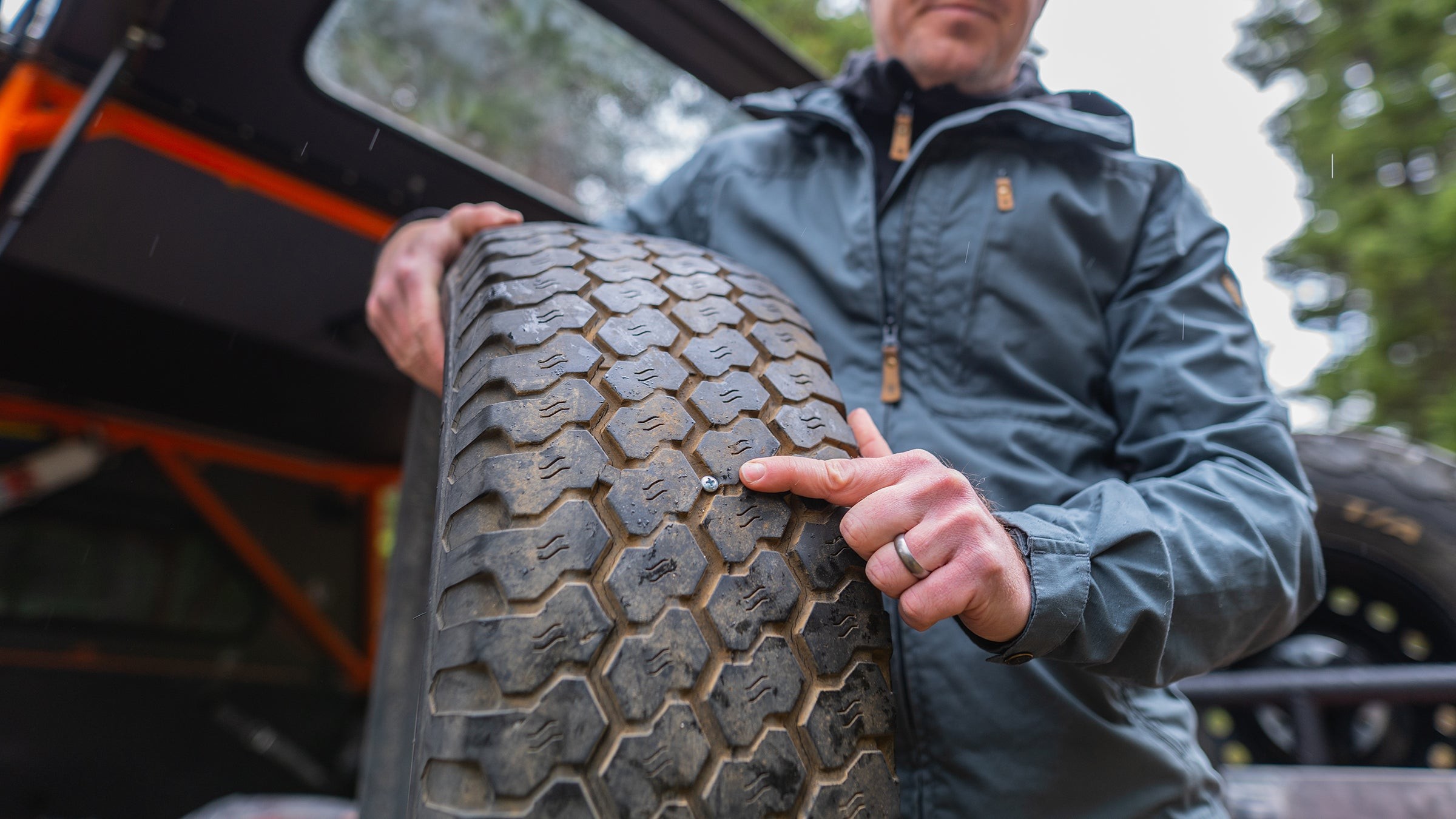Dealing with a flat tire is a common headache for drivers, and for outdoor enthusiasts venturing off the beaten path, it can become a real predicament. Punctures happen, especially on rugged terrains, and while spare tires are helpful, they aren’t always a foolproof solution. Knowing how to repair a tire yourself can be a game-changer, providing self-reliance and saving you from potential roadside emergencies. This guide will walk you through the process of how to repair tire on car, ensuring you’re equipped with the knowledge to handle a flat tire situation confidently.
Recognizing a Tire Puncture
The first step in how to repair tire on car is identifying when you have a puncture. On paved roads, a wobbly steering wheel or a rhythmic thumping sound that increases with speed are clear indicators of a flat tire. Off-road, at slower speeds, you might hear the thumping before you feel it. In either scenario, safety is paramount. Find a secure location to pull over immediately to prevent further damage to your tire or vehicle.
Why You Can’t Always Rely on a Spare Tire
While spare tires are standard equipment, relying solely on them isn’t always practical. Many modern vehicles come with space-saver spares, often called “donuts.” These are designed for limited, low-speed use – just enough to get you to a tire shop. Using a space saver on challenging terrains or for long distances is not advisable.
Even if you have a full-size spare, punctures can occur in multiples. Imagine facing two flat tires simultaneously in a remote area. Without the knowledge and tools for tire repair, you could be in a difficult situation.
Essential Tools and Materials for Tire Repair
Fortunately, assembling a tire repair kit is affordable and the tools are compact, making it easy to store in your vehicle. The cost is minimal compared to professional tire shop plug services or towing fees. There’s really no reason not to carry these essentials.
A comprehensive tire repair kit, like the Boulder Tools kit, typically includes rope plugs and the necessary insertion tools. Superior kits will also include helpful extras such as needle-nose pliers, spare valve cores, and a utility razor blade.
You’ll also need a portable air compressor. This is crucial for reinflating your tire after the repair. For emergency use, a Slime compressor that plugs into your car’s 12-volt outlet is a convenient option. While not designed for regularly inflating large off-road tires, it’s perfect for emergency situations.
A can of Fix-a-Flat is another valuable addition to your car’s emergency kit. This sealant and inflator combination can often fix small punctures caused by nails or screws without even removing the wheel. This can be particularly useful in hazardous locations where wheel removal is unsafe, or when you need to move your vehicle a short distance to a safer spot.
Lastly, a quality tire pressure gauge is essential. Regular tire pressure checks, ideally monthly, help maintain optimal tire condition, fuel efficiency, and handling. Temperature changes and time can affect tire pressure, so monitoring and adjusting as needed is important.
Step-by-Step Guide to Repairing Your Tire
Now, let’s delve into the practical steps of how to repair tire on car when you encounter a puncture.
Step 1: Locate the Puncture
Once you’ve parked safely, inspect the flat tire to find the puncture source. Sometimes, the culprit, like a nail or screw, will be immediately visible. If not, slowly rotate the tire to examine the entire surface.
If you spot a nail or screw firmly embedded in the tread and have Fix-a-Flat, use it first. Follow the can’s instructions to connect it to the tire valve and empty its contents. The tire should visibly inflate. If it returns to a usable shape, drive cautiously for a few miles, then recheck the tire pressure and adjust if needed. Monitor the tire closely at each stop. While Fix-a-Flat can be a quick fix, it’s still recommended to perform a proper plug repair later for a more permanent solution.
If you can’t locate the puncture, if it’s a larger hole, or if you don’t have Fix-a-Flat, you’ll need to remove the wheel to proceed with the repair.
Step 2: Prepare to Remove the Wheel (If Necessary)
Safety first! Before jacking up your car, place your spare tire under the vehicle’s frame near the flat tire. This acts as a safety measure in case the car slips off the jack.
Loosen the lug nuts on the flat tire before raising the vehicle. Remember “lefty loosey” – turn the wrench counter-clockwise to loosen.
Consult your vehicle’s owner’s manual for the correct jacking points and procedures. Position the jack securely and raise the vehicle until the flat tire is off the ground.
Once raised, fully remove the lug nuts and place them in a safe spot. Carefully pull the wheel towards you, being mindful of its weight.
Step 3: Assess the Damage
Examine the punctured tire closely. A puncture in the tread area is usually repairable. However, if the damage is on the sidewall (the vertical side of the tire), a plug repair is not safe. In this case, mount your spare tire and seek professional tire replacement as soon as possible.
For tread punctures, if Fix-a-Flat wasn’t used or didn’t hold, roll the tire to a safe workspace away from traffic. Look for the puncture again. If you find a small hole that has stopped leaking air, mark it for easy identification later.
Step 4: Remove the Puncturing Object
If a foreign object is lodged in the tire and it’s losing air, remove it using needle-nose pliers from your repair kit. While the video referenced uses a screw gun (for demonstration purposes), in most real-world situations, the object won’t be as deeply embedded and should be easier to pull out.
Be prepared to remove various objects – from nails and screws to more unusual items like pieces of metal or sharp debris. If the puncture was caused by organic matter, like a twig, try to remove any residue from the hole.
Step 5: Prepare the Hole with the Reamer
If the puncture hole is smaller than the diameter of a pencil, use the reaming tool from your tire repair kit to enlarge and clean it. This prepares the hole to properly receive the tire plug.
For small holes, inserting the reamer might require some force initially. Screw the reamer into the hole with downward pressure, or simply push it in and out repeatedly until the hole is large enough to insert the reamer with minimal effort. The goal is to create a clean, appropriately sized opening for the plug.
Step 6: Prepare the Plug
Take a rope plug from your tire repair kit. These plugs are designed to be inserted into the puncture and seal it from the inside.
Step 7: Insert the Tire Plug
Flatten one end of the rope plug using the needle-nose pliers. Thread the flattened end through the eyelet of the plug insertion tool. Use the pliers to pull the plug through the eyelet until equal lengths of the plug extend from both sides of the tool’s eyelet.
Apply lubricant from your repair kit to the plug and the tip of the insertion tool. This lubrication helps the plug slide into the tire more easily.
Position the tool tip over the puncture hole. Grip the tool firmly with both hands and push it straight into the hole until the depth guide on the tool is flush with the tire tread. Then, quickly and forcefully yank the tool straight out. The plug should remain inside the tire as you remove the tool.
Trim the excess plug material flush with the tire tread using the razor blade from your kit.
For minor punctures, one plug is usually sufficient. For larger punctures, you might need to insert a second or even third plug. If multiple plugs are needed, it’s crucial to have the tire professionally inspected and possibly replaced at the earliest opportunity. However, in most cases, a single plug will effectively seal the puncture for temporary or even longer-term use.
Step 8: Re-inflate and Reinstall the Wheel
Use your portable air compressor to inflate the tire to the recommended pressure. This pressure is typically listed on a sticker inside your driver’s side doorjamb or in your owner’s manual.
Once inflated, reinstall the wheel by reversing the removal steps. Hand-tighten the lug nuts in a star pattern to evenly secure the wheel against the hub. After lowering the vehicle and removing the jack, use the lug wrench to fully tighten the lug nuts, again in a star pattern (“righty tighty” – clockwise to tighten). Check the lug nut tightness again later that day.
Stow all your tools, the jack, and the lug wrench back in their designated storage locations in your vehicle.
Preventing Tire Trouble
Prevention is always better than cure. Regular tire maintenance can significantly reduce the chances of punctures and flats.
- Regularly inspect your tires: Look for signs of wear, embedded objects, or damage.
- Replace worn tires: Replace tires before the tread depth reaches 2/32nd of an inch. Use the penny test: insert a penny upside down into the tread. If Lincoln’s head is visible, it’s time for new tires.
- Check tire age: Tires have a maximum lifespan of six years, regardless of tread wear. Locate the DOT code on the sidewall to determine the manufacturing date.
- Use appropriate tires: For off-road driving, use all-terrain tires designed for better puncture resistance, especially in the sidewalls.
- Ensure you have tire changing tools: Always verify that your vehicle is equipped with a lug wrench and jack, and know how to use them.
By following these steps on how to repair tire on car and practicing preventative maintenance, you can confidently handle flat tire situations, ensuring safer and more enjoyable journeys, wherever the road may take you.


